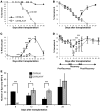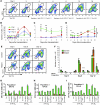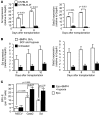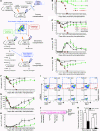Murine erythroid short-term radioprotection requires a BMP4-dependent, self-renewing population of stress erythroid progenitors
- PMID: 21060151
- PMCID: PMC2993581
- DOI: 10.1172/JCI41291
Murine erythroid short-term radioprotection requires a BMP4-dependent, self-renewing population of stress erythroid progenitors
Abstract
Acute anemic stress induces a systemic response designed to increase oxygen delivery to hypoxic tissues. Increased erythropoiesis is a key component of this response. Recovery from acute anemia relies on stress erythropoiesis, which is distinct from steady-state erythropoiesis. In this study we found that the bone morphogenetic protein 4-dependent (BMP4-dependent) stress erythropoiesis pathway was required and specific for erythroid short-term radioprotection following bone marrow transplantation. BMP4 signaling promoted the development of three populations of stress erythroid progenitors, which expanded in the spleen subsequent to bone marrow transplantation in mice. These progenitors did not correspond to previously identified bone marrow steady-state progenitors. The most immature population of stress progenitors was capable of self renewal while maintaining erythropoiesis without contribution to other lineages when serially transplanted into irradiated secondary and tertiary recipients. These data suggest that during the immediate post-transplant period, the microenvironment of the spleen is altered, which allows donor bone marrow cells to adopt a stress erythropoietic fate and promotes the rapid expansion and differentiation of stress erythroid progenitors. Our results also suggest that stress erythropoiesis may be manipulated through targeting the BMP4 signaling pathway to improve survival after injury.
Figures






Similar articles
-
BMP4/Smad5 dependent stress erythropoiesis is required for the expansion of erythroid progenitors during fetal development.Dev Biol. 2008 May 1;317(1):24-35. doi: 10.1016/j.ydbio.2008.01.047. Epub 2008 Feb 15. Dev Biol. 2008. PMID: 18374325 Free PMC article.
-
The MAPK ERK1 is a negative regulator of the adult steady-state splenic erythropoiesis.Blood. 2010 May 6;115(18):3686-94. doi: 10.1182/blood-2009-09-242487. Epub 2010 Mar 11. Blood. 2010. PMID: 20223923
-
EPO-mediated expansion of late-stage erythroid progenitors in the bone marrow initiates recovery from sublethal radiation stress.Blood. 2012 Sep 20;120(12):2501-11. doi: 10.1182/blood-2011-11-394304. Epub 2012 Aug 13. Blood. 2012. PMID: 22889760 Free PMC article.
-
Stress erythropoiesis: new signals and new stress progenitor cells.Curr Opin Hematol. 2011 May;18(3):139-45. doi: 10.1097/MOH.0b013e32834521c8. Curr Opin Hematol. 2011. PMID: 21372709 Free PMC article. Review.
-
Stress erythropoiesis: definitions and models for its study.Exp Hematol. 2020 Sep;89:43-54.e2. doi: 10.1016/j.exphem.2020.07.011. Epub 2020 Aug 2. Exp Hematol. 2020. PMID: 32750404 Free PMC article. Review.
Cited by
-
Monocyte-derived macrophages expand the murine stress erythropoietic niche during the recovery from anemia.Blood. 2018 Dec 13;132(24):2580-2593. doi: 10.1182/blood-2018-06-856831. Epub 2018 Oct 15. Blood. 2018. PMID: 30322871 Free PMC article.
-
Inflammation induces stress erythropoiesis through heme-dependent activation of SPI-C.Sci Signal. 2019 Sep 10;12(598):eaap7336. doi: 10.1126/scisignal.aap7336. Sci Signal. 2019. PMID: 31506384 Free PMC article.
-
Stress Erythropoiesis is a Key Inflammatory Response.Cells. 2020 Mar 6;9(3):634. doi: 10.3390/cells9030634. Cells. 2020. PMID: 32155728 Free PMC article. Review.
-
Microenvironmental dynamics in steady-state and stress erythropoiesis.Blood Sci. 2025 Feb 11;7(1):e00219. doi: 10.1097/BS9.0000000000000219. eCollection 2025 Jan. Blood Sci. 2025. PMID: 39949502 Free PMC article. Review.
-
FAM210B Regulates Iron Homeostasis and Sex-Specific Responses in Stress Erythropoiesis.bioRxiv [Preprint]. 2025 May 9:2023.09.26.559581. doi: 10.1101/2023.09.26.559581. bioRxiv. 2025. Update in: Exp Hematol. 2025 May 10:104797. doi: 10.1016/j.exphem.2025.104797. PMID: 37823037 Free PMC article. Updated. Preprint.
References
Publication types
MeSH terms
Substances
Grants and funding
LinkOut - more resources
Full Text Sources
Molecular Biology Databases

